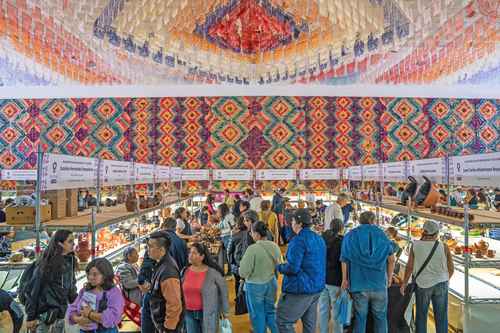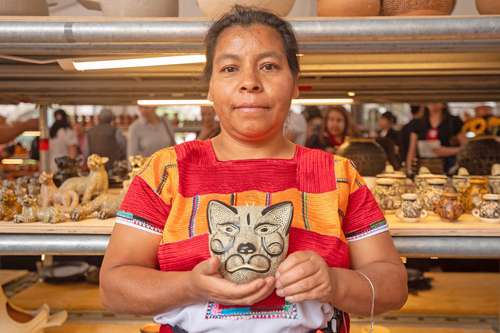With visual poetry, Daniel Alcalá engages in an epistolary dialogue with Mathias Goeritz.

With visual poetry, Daniel Alcalá engages in an epistolary dialogue with Mathias Goeritz.
Letters to Werner Brunner consists of 30 pieces made of materials such as paper, vinyl, cement on canvas and gold // It is housed in the Humboldt building, in the Centro neighborhood
▲ Through thirty pieces made of cut paper, vinyl, gold, and cement on canvas, the Coahuileño artist recreates a network of historical references, links between Mexico and Spain, and nods to figures in art and architecture such as Mario Pani, Félix Candela, and Vicente Rojo. Photo by Roberto García Ortiz
Eirinet Gómez
La Jornada Newspaper, Tuesday, June 17, 2025, p. 2
Through the visual poetry project Letters to Werner Brunner, the artist Daniel Alcalá Guzmán (Piedras Negras, Coahuila, 1974) pays tribute to the sculptor and architect Mathias Goeritz, a key figure in the renewal of art and architecture in Mexico during the 20th century, for his avant-garde and spiritual vision.
With 30 pieces made from cut paper, vinyl, and elements such as gold and cement on canvas, Alcalá constructs a framework of historical references, links between Mexico and Spain, and nods to figures such as Mario Pani, Félix Candela, and Vicente Rojo.
In an interview with La Jornada, Alcalá Guzmán explained that the idea of starting an exchange of letters with Goeritz arose from his interest in the landscape, but not so much the built landscape, but the natural landscape
. This interest led him to research modern architecture in Mexico and its protagonists: Luis Barragán, Ignacio Díaz Morales, and, finally, Goeritz.
He explained that, after exploring painting, sculpture, architecture, and installation, he became interested in the visual poetry that Goeritz vigorously practiced in dialogue with international avant-garde movements. "He was always very close to the world's art movements. One of his best-known facets was concrete poetry—in vogue in Europe and South America at the time—of which he was one of the pioneers in Mexico.
Visual poetry was a revelation to me, because I like the idea that it's no longer so much what you say with words that matters, but the text as an image. That idea of playing with texts and creating visual games interests me a lot
, he added.
Artistic letters
In Letters to Werner Brunner – the first name and second surname of Mathias Goeritz, which the artist used as a pseudonym – the 30 works are conceived as visual letters
, in an attempt to foster a dialogue with him and his time, on topics such as architecture, art and modernity.
The pieces were created over eight years, including a residency in Guadalajara, a period in Mexico City, and a stay in Madrid. I sought to establish a dialogue through visual integration, which involves the coexistence of art and architecture, such as that promoted by Goeritz in collaboration with architects and urban planners such as Félix Candela, Pedro Ramírez Vázquez, and Vicente Rojo
.
Typographic games
The collection features fabric pieces with cut-out and superimposed typography, creating a play on letters, emptiness, shadow, and volume. Other pieces are white, made with Fabriano paper, which play with the W and M of Werner and Mathias. Also visible is a self-adhesive vinyl, simulating ironwork, featuring a typographic play.
“In 1963, Mathias received an invitation to contribute to a visual poetry magazine. Following this, he developed pieces in which he repeatedly used the word 'gold.' This visual poetry project was born from that publication, which is why I developed some works in which I also use that word.”
The exhibition includes several key books, such as Mathias Goeritz by Olivia Zúñiga, considered one of the first revisions of his work. It's a gem, because much of what is known about Goeritz dates back to the 1970s and 1980s, but this volume refers to pieces from 20 years earlier
.
Other important titles on display include Mathias Goeritz: Modernist Art and Architecture in Cold War Mexico by Jennifer Josten, and Mathias Goeritz and Emotional Architecture: A Critical Review (1952-1968) by Daniel Garza Usabiaga.
For Daniel Alcalá, one thing we should learn from Goeritz's modern perspective is the way in which art and architecture can be closely related. "This so-called 'plastic integration,' where the architect invited the artist to collaborate, to engage in dialogue, is what this project seeks to emphasize. In these turbulent times, it proposes bringing us closer together and reaching agreements to work together."
The exhibition, which opened last weekend and will remain open until June 28 at the Humboldt Building (Article 123, number 116-2, Centro neighborhood), seeks to share a personal interpretation of Mathias Goeritz and provide the framework for each visitor to construct their own.
More than 60 thousand visitors received Original: Decorative and Utilitarian Art

▲ The event brought together 247 artisans from 28 states, who offered their products without intermediaries. Some of the creators sold out of their products before the last day of this initiative organized by the Federal SC. Photo: Federal Secretariat of Culture

▲ Aleyda Menor Hernández. Photo: Federal Ministry of Culture

▲ Francisca Lidia Sánchez Guzmán. Photo: Federal Ministry of Culture

▲ Ricardo Molina Sarmiento. Photo: Federal Ministry of Culture

▲ Ángela López. Photo: Federal Ministry of Culture
From the Editorial Staff
La Jornada Newspaper, Tuesday, June 17, 2025, p. 3
With an attendance exceeding 60,000, Original: A Gathering of Decorative and Utilitarian Art concluded at the Los Pinos Cultural Complex, where 200 groups participated, from June 12 to 15.
The event, organized by the federal Ministry of Culture, brought together 247 artisans from 28 states to offer their products without intermediaries, allowing them to earn higher incomes and gain greater visibility.
Some of the creators even sold out of their products before the final day of this initiative, after which they placed a sign in their spaces that read: All sold
.
This edition featured unique pieces that combine functionality, aesthetics, and ancestral knowledge. There were pottery and ceramics, plant fibers, wood, textiles, metalwork, maque and lacquer, stonework and stonework, cardboard and paper, glass, and Wixárika art, all spread across seven modules.
The distribution allowed the public to purchase, discuss, and understand firsthand the complexity involved in creating these pieces.
Among the artisans who benefited from the sales was Alcibiades Camilo Altamirano, from San Agustín Oapan, Guerrero, who sold his last piece on Saturday afternoon. "I wasn't familiar with Original; I only brought 40 pieces. I came from a fair in Ixtapan, and I didn't sell any, but I'm done here
," he commented.
Eulalia Gallardo Hernández, from Santa María Tlahuitoltepec, Oaxaca, who learned to work Mixe pottery with her mother-in-law, commented: I can't complain, I have sold well, I brought three boxes full (of pitchers, candlesticks, glasses, owl figures and mezcal cups) and I have already sold two, and the third is well underway
, she commented.
From Amatenango del Valle, Chiapas, the land where the clay jaguars were born, Ángela López Pérez brought pots, doves, roosters and jaguars of different sizes made by the hands of the 10 women who make up the Cerámica Cielo collective: Not only am I selling, but my entire group brings their merchandise so that we can all improve
.
Sisters Andrea and Susana Torres, from Morelia, Michoacán, arrived very early and were among the last to leave. We haven't tired of looking and walking around; we'd like to buy more, but we're leaving with our hands full. Every item made is worth what it costs
, they assured us.
In addition to the sales, specialized workshops were also offered for the public, from children to seniors. 49 activities were held under the Kids program, including storytelling, traditional games, music performances, and workshops.
The Nanas y Tatas talk was also held, aimed at those over 60, in which master artisans taught techniques such as unraveling, cutting and assembling sheet metal, scraping and grating atecomatl (gourd), among other tasks.
Gastronomy also played a prominent role in this project, featuring traditional cooks and their smoked kitchens, allowing the public to enjoy dishes from various regions of the country.
After walking for more than three hours among the sales booths, Adriana Olvera and Hubert, carrying a set of cups from Aguascalientes made with tzalam wood and wax candles from Tlayacapan, Morelos, agreed that the selection of pieces is of very high quality; they see a very diverse dynamic of crafts. The youth there are pushing forward in an incredible way; with a lot of imagination, they are creating impressive things. It's a very vibrant craft
.
Young people learn the trade and leave their mark, said Galileo Danny Mauricio Flores, an artisan from San Salvador Huixcolotla, Puebla, who accompanied his father, Danny Pedro Mauricio Bonilla, from whom he inherited his love for papel picado and the technique for working with it.
My father has created a legacy, and I believe it shouldn't be lost. It's also a family business. At 10 or 11 years old, I started gluing threads, helping out with what little I could learn at the time. Over time, I improved
, the young man said.
From the traditional figures of picos and catrinas that Danny Pedro's father and Galileo's grandfather made since the middle of the last century, they are now exploring other figures such as a skull with a mermaid's tail and butterfly wings that, according to the father, is inspired by nahuales.
jornada





